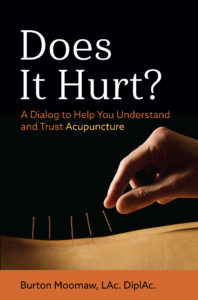
Acid reflux is a very common digestive problem. Also known as GERD (gastroesophageal reflux disease) it is recognized to affect 20% of the US population. Acupuncture is very effective in helping with acid reflux and I treat patients suffering with it frequently.
My patients with acid reflux are usually very surprised by Chinese medical theory’s analysis of the condition. It is very logical and makes sense to them. This explanation enables a few simple changes to help themselves.
Rebellious Stomach Chi
In Chinese medicine it is evident that the energy of the stomach moves downward. The stomach channel begins at the base of the eye and descends along the neck, torso, and legs ending at the third toe. Downward movement is clear when we consider that food enters our mouth, descends to the stomach, small intestines, large intestine, and then exits, falling down with gravity. When this movement is compromised, upward movement can occur resulting in nausea, heartburn, GERD, vomiting, vertigo, or headaches. These are all known as rebellious stomach chi.
What are possible causes of rebellious stomach chi? As with most problems with our health, there are usually multiple factors at work simultaneously. An outstanding feature of Chinese medicine is the determination of the root cause of health problems, not just the assessment and treatment of symptoms. By determining then treating the root cause of each individual case of acid reflux, the symptoms improve on their own. There are two predominant types of rebellious stomach chi: deficiency and excess.
Deficiency Origin Rebellious Stomach Chi
Many variables can lie at the root of acid reflux. In the case of deficiency reflux these factors lead to weakening of the stomach energy so that it no longer moves downward, but instead upward carrying stomach acid with it. Modern medicine treats every case of acid reflux the same way, using medications that, by one mechanism or the other, reduce the acidity of the stomach. In at least 50% of cases this is the wrong approach. These chemicals can further weaken an already weak stomach when in fact it should be strengthened. Acupuncture treatments for acid reflux originating in deficiency warm and strengthen the stomach allowing it to move downward again, ending the reflux. Lifestyle and dietary factors that contribute to this form are drinking ice-cold drinks and eating cold and raw food, stress involving worry and non-stop thinking, and most pharmaceutical medications. Apple cider vinegar usually temporarily improves this type of reflux.
Excess Origin Rebellious Stomach Chi
Excess type rebellious stomach chi Is a condition where the stomach truly is too hot. Heat means hyper or too much. In this case there is hyper-activity of the stomach, increasing acid production. As with all of nature, heat (stomach acid) rises, burning that which is above, in this case the esophagus. Treatment for excess reflux is to clear the pathogenic heat allowing the stomach energy to descend again. Lifestyle and dietary factors that contribute to excess acid reflux include a diet high in heating foods such as onions, garlic, chili, alcohol, coffee and chocolate. Emotional triggers for acid production include stress involving anger and frustration. GERD medications are usually effective for excess type reflux but do not correct the underlying problem. Acupuncture on the other hand addresses the underlying problem by clearing the heat so that acid production can normalize and the stomach energy can descend, no longer carrying acid upward.
As with all medical conditions, there are more than these two causes of acid reflux. Chinese medical diagnosis is very refined and can pinpoint the underlying cause of each patient’s issue and treat it effectively.
 You will find more in-depth descriptions of these theories, case studies, and illustrations in my introductory book on acupuncture, Does It Hurt? A Dialog to Help You Understand and Trust Acupuncture. This book demystifies acupuncture for medical professionals and those curious about trying acupuncture, and is a valuable resource for practicing acupuncturists to explain the theories to their patients in layman’s terms.
You will find more in-depth descriptions of these theories, case studies, and illustrations in my introductory book on acupuncture, Does It Hurt? A Dialog to Help You Understand and Trust Acupuncture. This book demystifies acupuncture for medical professionals and those curious about trying acupuncture, and is a valuable resource for practicing acupuncturists to explain the theories to their patients in layman’s terms.
Photo by Shelley Pauls on Unsplash




Comments are closed.